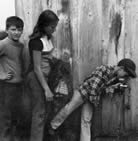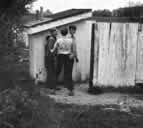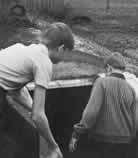 |
Volume I, No. 1, Fall 1973 |
Our Link to the Past
The section on modern one-room schools was compiled and written by Jay Luthy based on
interviews, research and personal experience. He was assisted by Jim Baldwin, Terry Tyre, and
Janet Florence.
Photography by Robert McKenzie, Steve Hough and Ronnie Hough.
One-room rural school? Oh, that's what they used a hundred years ago, right?
Wrong!
The average person, if he has even heard of a one-room rural school, tends to push it back in ancient history, but these schools aren't so ancient. In the Missouri Ozarks there have been rural schools until May, 1973.
Ancient?
Well, maybe, but we 'prefer to think of country schools as our modern link to the past. 'Up till now this link has been so much a part of us that we have trouble writing about the schools in the past tense.
Even without much knowledge of this type of school, most people think of a small frame building painted white with a bell tower on top. That, of course, is what most tend to look like, although they may have the bell on a pole or just use a small hand bell. The school building design just hasn't changed much in the last hundred years.
 |
 |
 |
The interior of the building is where all the change has occurred. The last schools, which closed this spring, had tile floors, fire extinguishers, refrigerators, pianos, telephones, overhead projectors, 16mm projectors, film screens, photo copiers, duplicating machines, sets of encyclopedias and small libraries up to 250 books which were serviced monthly by a regional bookmobile and weekly by a regional audio-visual library.
The style of the desks changed, too. Instead of the old type of double desks that were all hooked together in a line, the modern rural schools used the same type of desk used by many large elementary schools, a small table and chair far each child.
Still, none of the schools were straight out of 2001, or even 1973, for that matter. A few had running water; most had hand pumps. Some had indoor restroom facilities; most still used the two primitive outhouses located on opposite corners of the school ground. A small number had lunch programs, but the schools we visited did not. The students brought their lunches in paper sacks or lunch pails which they stored on a screened shelf. Some of the schools even lacked such amenities as window shades.
But enough of this. Let's find out what it was like to attend a rural school or to teach in one--from the people who know.
Boys enter storm cellar
[6]
Copyright © 1981 BITTERSWEET, INC.
Next Article | Table of Contents | Other Issues

